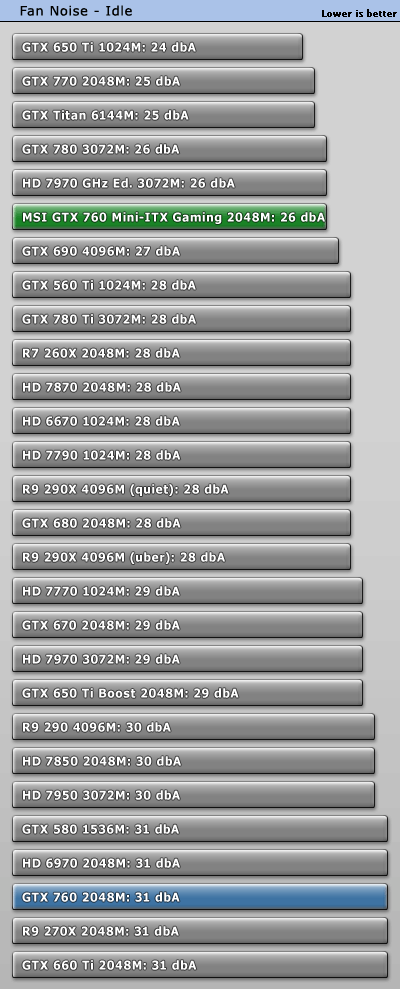 20
20
MSI GTX 760 Mini-ITX Gaming 2 GB Review
Performance Summary »Fan Noise
In past years, gamers would accept everything for a little bit more performance. Nowadays, users are more aware of their graphics card's fan noise and power consumption.In order to properly test the fan noise a card emits, we use the Bruel & Kjaer 2236 sound-level meter (~$4,000). It has the measurement range and the accuracy we are looking for.

The tested graphics card was installed in a system that was completely cooled passively. That is, passive PSU, passive CPU cooler, and passive cooling on the motherboard and solid state drive. Noise results of other cards on this page are measurements of the respective reference design.
This setup allows us to eliminate secondary noise sources and test only the video card. To be more compliant with standards like DIN 45635 (we are not claiming to be fully DIN 45635 certified), the measurement was conducted at a distance of 100 cm and 160 cm off the floor. Ambient background noise in the room was well below 20 dBA for all measurements. Please note that the dBA scale is not linear but logarithmic. 40 dBA is not twice as loud as 20 dBA, as a 3 dBA increase results in double the sound pressure. The human hearing perception is a bit different, and it is generally accepted that a 10 dBA increase doubles the perceived sound level. 3D load noise levels were tested with a stressful game, not with Furmark.
MSI did a good job with noise. The MSI GTX 760 Mini-ITX GAMING is almost whisper quiet in idle, which should make it quiet enough to be inaudible inside a case next to your living room TV (at a realistic TV-watching distance).
The fan ramps up during gaming, but stays pretty quiet for a card targeting small form factor systems. Noise levels also depend on your case's airflow, which is usually more limited in a mini-ITX case than a fully sized desktop.


Apr 1st, 2025 17:54 EDT
change timezone
Latest GPU Drivers
New Forum Posts
- Is the futureproof gaming solution a four drive system? (36)
- lowering the voltage but performance decreased a lot. (5)
- Asus Rampage IV Formula Bios MOD (NVME Support + Resizable BAR) (0)
- What do you do for a living? (473)
- RTX 3090 is still a good card? (15)
- Is RX 9070 VRAM temperature regular value or hotspot? (280)
- Question about Intel Optane SSDs (59)
- [Intel AX1xx/AX2xx/AX4xx/AX16xx/BE2xx/BE17xx] Intel Modded Wi-Fi Driver with Intel® Killer™ Features (300)
- What are you playing? (23331)
- 5090 is terrible (3)
Popular Reviews
- DDR5 CUDIMM Explained & Benched - The New Memory Standard
- Sapphire Radeon RX 9070 XT Pulse Review
- ASRock Phantom Gaming B850 Riptide Wi-Fi Review - Amazing Price/Performance
- SilverStone Lucid 04 Review
- Palit GeForce RTX 5070 GamingPro OC Review
- Samsung 9100 Pro 2 TB Review - The Best Gen 5 SSD
- Sapphire Radeon RX 9070 XT Nitro+ Review - Beating NVIDIA
- Enermax REVOLUTION D.F. 12 850 W Review
- Assassin's Creed Shadows Performance Benchmark Review - 30 GPUs Compared
- AMD Ryzen 7 9800X3D Review - The Best Gaming Processor
Controversial News Posts
- MSI Doesn't Plan Radeon RX 9000 Series GPUs, Skips AMD RDNA 4 Generation Entirely (146)
- Microsoft Introduces Copilot for Gaming (124)
- AMD Radeon RX 9070 XT Reportedly Outperforms RTX 5080 Through Undervolting (119)
- NVIDIA Reportedly Prepares GeForce RTX 5060 and RTX 5060 Ti Unveil Tomorrow (115)
- Over 200,000 Sold Radeon RX 9070 and RX 9070 XT GPUs? AMD Says No Number was Given (100)
- NVIDIA GeForce RTX 5050, RTX 5060, and RTX 5060 Ti Specifications Leak (96)
- Retailers Anticipate Increased Radeon RX 9070 Series Prices, After Initial Shipments of "MSRP" Models (90)
- China Develops Domestic EUV Tool, ASML Monopoly in Trouble (88)
